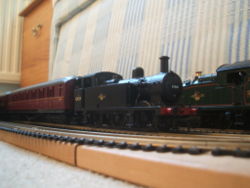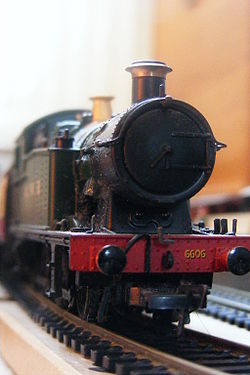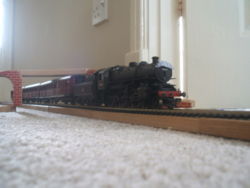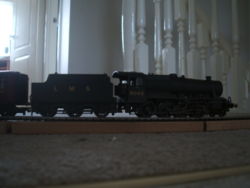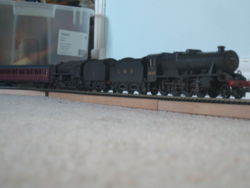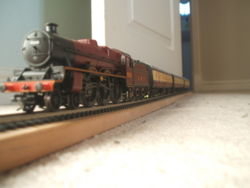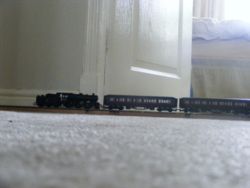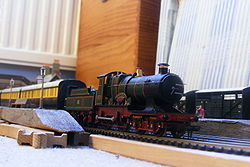Apple Tree railway
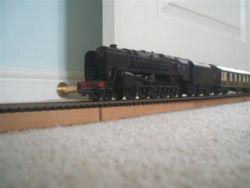 Apple Tree Railway's #92134 passes Lumbridge.
| |
| Power type | Sandard Rail |
|---|---|
| Type of service | Passenger |
| Era | Heritage railway, running restored steam engines |
| Scale | OO Scale |
| Gauge | 4 ft 8½ in (1435 mm) |
| Number of tracks | 1 |
| Length of track | 8 miles |
| Trains running at once | 4 |
| Nicknames | Apple Tree line, ATR |
| Location | Dudbrook |
| UK Model Trains {{Infobox Model Layout}} | |
The Apple Tree Railway is a heritage railway that runs from Dudbrook to Wayworth-on-Sea in the county of Devon, in England. The line starts inland, but the route takes it closer to the sea when it reaches Wayworth-on-sea. Also nearby, is the well known downs, near Holme.
Contents
Overview
After opening in 1989 the railway has run restored full sized steam trains taking passenger and freight services. The line is in the top 70 tourist attractions in the United Kingdom. The railway has re-opened part of the Hayles to Wayworth-on-Sea line and restored three stations. The lines headquaters is in Dudbrook. This is where the works, sheds and sidings are. The line terminates in Wayworth-on-Sea, where there are two sidings. The railway passes Churchdown, where there is now a newly restored halt station. Near Wayworth-On-Sea, the railway passes the Holme downs. The railway now is home to thirteen operational steam engines, thirteen operational coaches and a selection of wagons.
Operations
The railway currently operates preserved steam trains from Dudbrook station to Wayworth-On-Sea station. There are four timetables used, the gold timetable is used throughout holidays and summer weekeneds. This timetable involves three steam trains running the entitre route. The red timetable is used on weekends, during lesser popular periods of the year. The red timtable involves two steam trains running the whole route. The blue timetable is only one steam train operating. Used on weekdays. The fourth is the special event timetable which varies, depending on the event. The railway operates throughout the year, on some weekdays and all weekends. The railway is currently closed due to the lack of locomotive available to run.
Apple Tree Railway history
Construction
In 1841 The Great Western Railway were approached many times by the fruit farms in Holme, asking if they would open a railway to transport thier fruit to the inner towns. This was talked about for five years, but no action was taken. However, after Wayworth-on-sea became a major sea-side resort and port, the GWR in 1846 decided that building a railway from Hayles to Wayworth-on-sea would be a good idea, and an important branchline. The line would not go to Holme directly, so a junction was created near Wayworth, so fruit trains could connect with Holme. The construction started in the 1850's, and was due to open in 1858 but opened two years late in 1860. The railway was one of many GWR broad gauge railways, but in 1880 was converted to the standard gauge.
Operation
When converted to standard gauge in 1880, there were frequent freight trains running from Holme to Hayles, as the fruit growing in Holme was of a good quality, and due to the lack of roads and lorries, train was the only way of transportation. The fruit industry benifited the Apple Tree Railway hugely, and it is thought that without the fruit growing areas in Holme, the GWR may never have built the line. Another reason the line was so popular was tourism. Many familles from cities such as Plymouth, Exeter and Truro would catch the train from their local station, and head to Wayworth-on-Sea, where they would spend the day. Wayworth-on-sea grew hugley due to the railway. By the 1920's, the line was well known in the South. In 1923 The Greatwestern Railway introduced three express trains a day running from Hayles to Wayworth-on-sea
The railway during World War Two.
The railway was massivley affected by the Second World War. The line played a huge part in evacuation of children throughout the period. Children from Plymouth, Truro and Exmouth were put on trains that went on the Apple Tree Railway. There were three evacuation trains each week on the line in September 1939, taking children and pregnant mothers to Holme and Churchdown, which were small less, venerable villages. By October 1939, 4,600 children had been evacuated by the ATR trains. A year later, evacuation trains were in use again, taking children back to their homes in the larger cities. Howver, again in June 1940, the ATR was used in re-evacuations, this time 3 thousand children were re-homed in Dudbrook, Wayworth, Churchdown or Holme, and again, the railway was very busy! Four years later, in 1944, Britain was under attack from German rockets. This meant for another evacuation. 5,000 people were taken on the Apple Tree Railway for evacuation, until 1945, when the war ended. During the war, more fruit train services were introduced by the government,so that cities such as Plymouth had food supplies. During the war, the ATR was one of the most important branchlines in Southern England. Also during the War, there was a bombing in Churchdown station, see below.
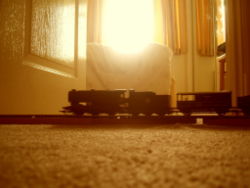
Churchdown bombing.
Another huge event that took place on the ATR during world war two, was the German attack on Churchdown station. At 10.00PM on April the 22nd 1941, a German bomber (unknown) wasn returning from its bombing of Plymouth. It is believed that the aircraft had spare bombs, and was therefore dropping them over the country, in the hope it may hit something or someone. Two bombs were dropped, one hit a field by the railway, near Wayworth-on-sea. This didn't kill or injur anybody, but the second bomb landed on Churchdown station car park. The station master, James Andrews, was killed in the bomb while he was sitting in the boking hall. The other victim was an innocent passenger, Paul O'Shea, who was waiting for a shuttle service to Holme. The bomb destroyed the entire station car park and building, and services stopped on the line for a week. The track was soon repaired. There is now a war mamorial in Churchdown station, in memory of James Andrews and Paul O' Shea.
The Name.
There are two main factors that lead to the railway getting its name. One being the constant fruit trains. Although apples weren't one of the fruits grown at Holme, people associated apples with the railway as it was a fruit commonly eaten in the area the line operated in. But the main reason that the Hayles to Wayworth-on-Sea line became known as the 'Apple Tree Railway' is, after the war in 1943 an orchard was planted along side the track near Wayworth-on-sea, and the trees growing there now produce alot of apples!! When the train past the 'Apple Tree stretch' the passangers could smell the fresh smell of apples from outside. The orchard was planeted in the spot one of the two German bombs fell. This name caught on, and now the 'Apple Tree Railway' is no longer a knickname, but is the official name!
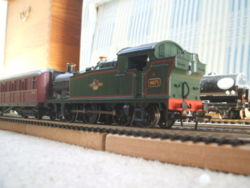
BR days and closure.
After the war, the government donated £50,000 to the railway, as it was such a great help in evacuation, and it needed to be attended to. There was no longer a station at Churchdown, just a track passing the rewins of a once beautiful station. The line was attended to and when BR took over the railways in 1948, the ATR was back to normal. But, the increasing use of road trafficing and lorries dominated the fruit industry, and fruit trains were no longer needed. This was a terrible disadvantage to the Apple Tree Railway, and there were only three trains in Holme station each day, this is three times less than what it was before the war. By the fifties, the line needed attention again, and the stations as needed repairing. This time, the government did not support the line. Passenger numbers dropped 40% by 1955. In 1960, there were no longer any fruit trains running on the line, and the line fell in to huge debt. In 1963, there was a derailment of trucks in Holme, and railway was closed.
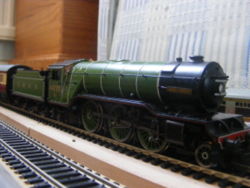
Preservation.
After the line closed in 1963, most families had cars, and were able to travel on roads from Hayles to Wayworth-on-Sea, and there was no real need for the line. It stayed in a derelict state until 1983, when there was an appeal to re-introduce the Apple Tree Railway, for tourists trains. It would be operated by Wessex trains. But after three years, the line was not bought by Wessex trains. In 1986, a group of railway enthusiasts set up the Apple Tree Railway society, and they raised funds to restore the line, and run steam trains on it. By 1988, they had re-laid the entire track from Dudbrook to Churchdown. Hayles could not be restored due to building on the track bed. In 1989, the railway was ready to be opened. On April the first weekend in April 1989, the Apple Tree Railway was opened by steam trains. GWR 14XX class #1436 and LNER A4 class 'Golden Plover' hauled the first trains on the line for 26 years and the event attracted 1 thousand people.
The 90's
The year of 1989 was a success for the ATR, it had finally re-opened three miles of track. At this stage, the railway operated with two coach Pullman trains to Churchdown. At the turn of the decade another locomotive was given to the newly restored railway, it was the sister engine of Golden Plover. The new engine was 'Golden Fleece'. For the first few years, the three engines were all in a running condition, but in 1994, Golden Plover broke down, and it was found the engine had two cracked pipes inside the boiler. The locomotive could not run and as the line was only five years old at the time, it couldn't be afforded to fix her. The line was struggling in 1997, and visitors went down 20%.
After 1994 the railway was in financial troubles. And another huge disaster was on the way. In 1997 1436, one of the lines first engines broke down, and it was an expensive repair to make. In 1997 the line was close to closing. By 1999 there was some hope. The line had three operational locomotives (The three original engines had all broken down, and could not be fixed on site). These engines were GWR Collet Goods class #2244, GWR Hall class #4936 ‘Kinlet Hall' and GWR 56XX class #6671. The financial situation was slightly better by 1999, and the line could carry on running two coach services from Dudbrook to Churchdown.
2000-2007
The new millenium arrived, and in January 2000 the line released a statement that indicated the line would extend to Wayworth-On-Sea in the ahead decade. The news of extension excited many people living locally to the railway. Many people, especially over the age of 60, joined the ATR society in order to get steam trains running to Wayworth-On-Sea once again. For the first seven years of the decade the line tried to raise funds for the extension. Plans were made, and the necessary items and equipment was ordered.
In the first seven years of the decade, the line ran two coach trains from Dudbrook to Churchdown. The rolling stock improved very little, the line continued running Pullman coaches along with one MK1 crimson cream coach. The loco fleet remained much the same from 2000 to 2006, the operational locomotives were GWR 56XX class #6671, GWR Collet Goods class #2244 and GWR Hall class #4936 'Kinlet Hall'. The locomotives performned well over the six years. They were occasionally joined with a visiting engine on loan from other steam railways. In 2007, around late December and early January the railway locomotive fleet expanded dramtically. Fve new resident engines arrived at Dudbrook in the space of a month. These locomotives included two 56XX tanks (meaning the line had three in total, 6671, 5660 and 6606), an Ivatt 4MT Mogul, another Hall class and a 3F Fowler Jinty tank. The line had a loco fleet of eight steam engines at this stage. This attracted many more people, volenteers and visitors. The new locos meant many more people came to the railway came to the line. The extra profit made from the extra passengers meant the line had enough money to complete extending the railway from Dudbrook to Wayworth-On-Sea.
Wayworth-On-Sea extension, April 2008
With the increase in money and passengers, the line could finnish the extention to Wayworth-On-Sea. Work had already been completed on the trackbed and track laying. In January/Febuary 2008 tests were made to the track, and final adjestments were arranged. The line confirmed the extension gala in late March, timetables were written and the final preperations were completed. The track between Churchdown and Wayworth was finnished completley in late March 2008, the extra five miles of track was ready to be used once again. The Apple Tree Heritage Railway now ran under Churchdown Bridge, past Holme curve and past the Orchard that gave the ATR it's name. The route was a total of eight miles with the new stretch of line. The line's extension gala was a three day event, starting on Saturday 15th April. The queen was at the event and was dining on the first train of the day, and the first train on the new extended line. The train was hauled by GWR Hall class #4936, "Kinlet Hall". The gala was a success and featured all the lines locos (excluding Guild Hall which was in need of repairs). One of the other huge attractions of the event was that one of the first ATR engines, one of the engines that opened the railway in the 1980's, Golden Fleece, was making an appearence. She ran only once every day hauling a freight train. The gala raised almost enough money to pay for the extension again, meaning that the line could purchase many more benifits such as new engines, better sidings, and an improvements to the stations. The railway later released the figures, that the extension cost £493,341. The extension may have been completed, but Wayworth station building wasn't completed and the signalling had to be controlled manually.
The destruction of Churchdown station
During the extension to Wayworth-On-Sea, around January 2008, a storm with 90MPH winds destroyed the station building and platforms at Churchdown. The railway insisted this was not a major blow, as the station was no longer needed (due to Wayworth being the new terminus), the station rubble was cleared, but the statio was not scheduled to be rebuilt. When the line re-opened, at the April extension gala, trains passed the site of Churchdown and didn't stop. This is first time Churchdown was not stopped at in the entire history of the preserved Apple Tree Railway.
'Upgrade' to DCC and the consequences
The Apple Tree Railway was controlled using standard signalling throughout it's working life, and when preserved was signalled using Electric Key Tokens. The EKT was used until September 2009, when the line upgraded to a more moden and advanced way of signalling, DCC. This new system cost the line roughly £100,000, not to mention the thousands invested in converting the engines to run on this control system. The new signalling system allows the line to run more than one train on the same line, and more engines to be working at once. Locomotives need to have a special piece of equipment fitted inside them to run on DC. These objects, known as chips, cost roughly £9,000 each and fitting them can also cost £10,000. When the line upgraded to DCC very few of the locomotives were able to run. When some of the few compatable engines failed the line had to make cancellations and give passengers full refunds. As some more engines were converted to DCC other broke down, such as 5660 and 33002. After several weeks of the line making cancelations, on the 1st of November, the decision was made to close the Apple Tree Railway temporerilly while the line fitted enough engines to DCC. The line also released a statement emphasising that the line was in major debt due to the upgrade to DCC. The line was due to be holding a gala in November but the closure of the line meant it had to be canceled. The railway did not operate until the 21th March 2010 (almost five months after the line was operational previously). Volenteers helped to the get line working again. Repairs were made to the track and the railway opened to the public on Easter Monday, 5th April 2010. It then went through a succession of closures and finacial problems. The original repairs to the track had failed and the railway took a while to recover. It was only after the arrivals of Nicola Cortese as chairman and Nigel Adkins as managing director that the railway bought new track and managed to recover. This coincided with the arrival of 3440 'City of Truro' from the National Railway Museum. On the 3rd octoer 2010 the railway was cloed by Nicola Cortese while track was replaced. This proved to a very unpopular decison. Cortese released the following statement on the Apple Tree Railway website:
"It has been a successfull time on the ATR, especially with our new arrival of City of Truro and Nigel Adkins as our managing director. Despite the celebration of this news, I write with some shocking and unwanted news.
The ATR has had major issues recently with the signalling and track. The permanent way department have been severely neglected under the old chairmanship of running of the railway. I am very dissapointed about this, but I reliase my job is to turn this round and improve the department. Afterrecently joining the ATR's senior management team I have undergone a major review of the railway's track.
Unfortunatley, the track is in a sorry and poor state, much to my dissapointment. The rialway is unsafe and simply not up to the high standards I, or any other ATR director, expect. Thus, after hard thought and lengthy disccsussions, I have made the decision along with my ATR collegues to close the railway while it undergoes a major upgrade. We will replace and repair track so the railway can run smoothly and safely from Dudbrook to Wayworth. This may take a month, and will hinder the progress of fitting locos with DCC.
I accept this is an unpopular decision, but it is for the best. We must work as a cohesive unit, and together we can get through this dark spell. Members, enthusiasts directors and me can look foward to being the best heritage line in the UK, once again.
No further comment will be made until the line is set to open."
But only eight days after the statement, 8th Ocotber 2010, the railway re-opened with brand new track, purchased with the railways funds by the chairman Cortese. The railway's opening weekend proved to be a huge success, attracting record numbers of people at a 'non-gala weekend' at a heritage railway in the UK. The railway used the opportunity to give 3440 City of Truro her debut, and 92134 'Sir Brian Saunders' her first run on DCC. Also running was 6606. This proved to be the spark in the Apple Tree Railway's recovory. Since then, the line hasn't closed and has been relatively stable loco wise and financially. Gradually the line had built up it's locomotive fleet available to run on the DCC system.
The Cortese era
After the DCC upgrade (see the above paragraph) the railway went through a succession of closures. The costs of the new DCC system proved to be too much for the Apple Tree Railway's funds. The cost for loco chips and the fitting of them to the boilers of locomotives was underestimated by the railway's chairman at first and the railway went bankrupt. The chairman stood down, leaving the railway in a neglected state. Only roughly five locomotives were operational, many of the non-operational locomotives were in desperate need of repiars and attention. This wasn't happning. The ATR needed some stable and strong leadership. Their answer to this was appointing an Italian/Swiss-banker and railway fanatic Nicola Cortese on 5th September 2010. His background in finance was viewed as ideal for taking the line out of debt and leading them foward. His ambition was also noted by the railway, who believed he was the man who would take them foward with DCC- reaching the potential that was there. The railway made these comments on their offical website:
We are pleased and proud to announce that the Apple Tree Railway have appointed Mr Nicola Cortese as our executive chairman. Mr Cortese has finance expertise that any railway would envy. He has a mind for business and is also a keen fanatic of steam trains. The appointment has been made to help the railway progress faster, after getting all of our sixteen locomotives operational on the state of the art DCC system.
These changes are no doubt exciting, and we have made a decision in order in ensure this progress becomes reality- not a dream or plan.
They then quoted Cortese, who made the following comments shortly after the appointment:
"I am very pleased and proud to be working at this great railway. The people are here- as are the locos. I know that I, with the help of my invaluable volunteers, will make this line great- like it was in late 2009. The difference being, we will run on DCC. My first job is to get the loco fleet to what it should be- which is around sixteen engines."
"I was attracted by the brilliant locos here, the determination of the volunteers, the enviable controlling system, and the immense potential here."
"I look forward to working at the line, and communicating with enthusiasts on this site".
Cortese started work on the sixth of September 2010. His first job was to finalise the agreements with the National Railway Museum that 3440 'City of Truro' would become a resident on the railway. But his first major decision was on the 21st September 2010, where he appointed Nigel Adkins as a managing director. The railway made the following statement when Adkins arrived:
The Apple Tree Railway are delighted to announce that they have appointed Nigel Adkins to be a new director of the line, thus assisting in the running and improving of the ATR. Adkins will be assistant to the ATR's new 'success hungry' chairman, Nicola Cortese, in his aim to increase the ATR's DCC loco tally back to around fifteen engines and sustaining that sucess.
The lines ambition was what attracted Mr Adkins to the railway, along with the potential. He described the line as "a magnificant heriatge railway". When asked why he took the job the reply was short and sweet: "Who wouldn't want to take this job". When getting out of the car at Dudbrook station for the first time, Adkins stood in ore- commenting "what a fantastic station".
Adkins was known as an ambitious and clever man, someone whom Cortese felt very strongly should be involved in the mission of improving the Apple Tree Railway. Adkins made the following comments after arrival:
"I am delighted to join the ATR. It is a proud honour to join a line with such great tradition and potential. I am very excited to take this new fresh challenge, and I look foward to taking the line foward, along with Nicola. I am optimistic of where we can take this railway".
The pair joined a number of other board members and executives who were already in place at the railway. Together they made it their aim to get the railway back to were it was in June 2009, but operating on DCC. They then wanted to take the line even further. Firstly, Cortese and Adkins had to conqure the issue of poor track quality (after being neglected previously).
In order to do this, Cortese closed the railway on 8th September 2010 for eight days. During that time period he arranged for new track to be installed and inspected. Cortese released this statement:
It has been a successfull time on the ATR, especially with our new arrival of City of Truro and Nigel Adkins as our managing director. Despite the celebration of this news, I write with some shocking and unwanted news.
The ATR has had major issues recently with the signalling and track. The permanent way department have been severely neglected under the old chairmanship of running of the railway. I am very dissapointed about this, but I reliase my job is to turn this round and improve the department. Afterrecently joining the ATR's senior management team I have undergone a major review of the railway's track.
Unfortunatley, the track is in a sorry and poor state, much to my dissapointment. The rialway is unsafe and simply not up to the high standards I, or any other ATR director, expect. Thus, after hard thought and lengthy disccsussions, I have made the decision along with my ATR collegues to close the railway while it undergoes a major upgrade. We will replace and repair track so the railway can run smoothly and safely from Dudbrook to Wayworth. This may take a month, and will hinder the progress of fitting locos with DCC.
I accept this is an unpopular decision, but it is for the best. We must work as a cohesive unit, and together we can get through this dark spell. Members, enthusiasts directors and me can look foward to being the best heritage line in the UK, once again.
No further comment will be made until the line is set to open.
The railway's opening was a huge success, attracting record numbers at a heritage railway for a non gala weekend. The weekend went well, and also saw the debut of 3440 'City of Truro' and the first run of 92134 'Sir Brian Saunders' on DCC. Since then, the railway has improved and re-grouped under Cortese and Adkins' leadership, and it currently looks set to return to around fifteen operational engines if not more.
Stations
The Apple Tree Railway has three fully restored stations on the line, that services frequently stop at. Dudbrook was the first to be restored and was recently upgraded to make it bigger and so it could hold more trains. The ATR called this the "Dudbrook Makeover". Churchdown Halt is the next station up the line. The halt has been destoryed twice. Once by a bomb and once by a storm. The railway re-opened the "new" Churchdown Halt a few years after being destroyed. The end of the line, Wayworth-On-Sea, has only been restored since April 2008. Until June 2009 the station didn't have a station building, footbridge or permanent platforms. The ATR have now built platforms and restored a footbridge there. The station building is set to be completed later this year.
The line also passes the site of two other stations, Holme Junction and Wayworth Halt, however both are wrecks and there is nothing remaining of them.
- Dudbrook station. The headquaters of the Apple Tree Railway.
- Churchdown halt Restored in January 2009.
- Holme Junction (closed)
- Wayworth halt (closed)
- Wayworth-On-Sea The current terminus station.
Operational Locomotives
The railway operates with just steam locomotives, and they all require a DCC chip in order to run on the railway. The railway currently has only three operational steam locomotives, because the remaining thirteen don't have DCC chips, and therefore can't run on the railway. The line is planning to regually be fitting more engines to the DCC system, but things have not gone to plan.
| Number & Name | Description | Current Status | Livery |
|---|---|---|---|
| No. 6671 | GWR 0-6-2T 5600 Class | Operational. | BR (late crest) Green |
| No. 43154 | LMS 2-6-0 4MT mogul | Operational | BR (early crest) Black |
| No. 92134 'Sir Brian Saunders' | BR 2-10-0 Standard 9F class | Operational | BR (late crest) Black |
| No. 6606 | GWR 0-6-2T 5600 Class | Operational | GWR Green |
| No. 5660 | GWR 0-6-2T 5600 Class | Operational | BR (early crest) Black. |
| No. 47629 | GWR 0-6-0T 3F fowler tank | Operational | BR (late crest) Black. |
| No. 33002 | GWR 0-6-0 Q1 Class | Operational | BR (early crest) Black. |
| No. 8042 | LMS 8F 2-8-0 8F Class | Operational. | LMS Black. |
| No. 5555 | GWR 2-6-2 4575 class | Operational. | Great Western green |
| No. 2244 | GWR 0-6-0 Collet Goods Class | Operational. Recently had intensive repairs | BR (late crest) Green |
| No. 16 | WPR 0-6-0ST J94 class | Operational | WPR livery. |
Non-operational Locomotives
The ATR operates a DCC system. To run on the railway engines must be fitted with a special DCC decoder. The railway hasn't had the finances to do this to many engines recently. But it is due to start fitting engines with DCC over the Easter weekend 2010.
| Number & Name | Description | Current Status | Livery |
|---|---|---|---|
| No. 5563 'Australia' | LMS 4-6-0 Jubilee Class | Repairs needed to the tender | LMS maroon. |
| No. 4771 'Green Arrow' | LNER 2-6-2 V2 class | Lacks a DCC chip, in need of repairs | LNER doncaster green. |
ATR Festival of Steam
The Apple Tree Railway's main annual event is a huge steam gala, where all, or as many as possible, of the steam locomotives run. The two biggest and most famous ones being in 2008, were Hall Class Guild Hall returned from major repairs and the 2009 event when two surprise new residents (J94 WPR No. 16 and 4575 GW 5555) made their debuts. This event proved to be the last one before the railway upgraded to a new signalling method.
At all of the festivals there are things to do in the stations, extra services running (including demonstrational freight trains, luxery dining trains, mixed traffic trains and shuttles) and the biggest attraction being the double heading of the engines and the triple heading of the three 56XX class engines.
In 2009 the line had many attractive double headers including 8042+Australia, 92134+8042, 4771+5555 and 6606+5660+6671. Also in 2009 BR 9F #92134 was named Sir Brian Saunders. At the 2009 festival the railway broke the record for most people at a heritage railway in one day. The railway makes most of it's money at this event. The money goes to improving the railway.

